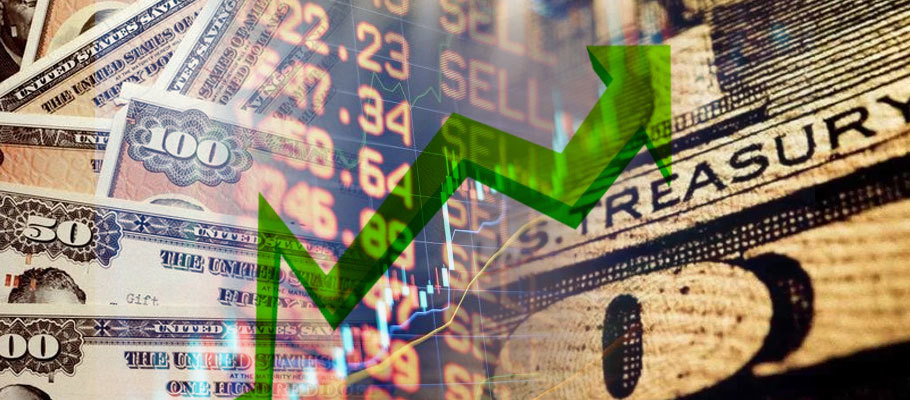
Published: May 17th, 2021
U.S. stocks surged for the second day running on Friday, May 14, as weakening commodity prices helped shelve concerns of imminent inflation risks. Shares in the energy and technology-laden S&P 500 index, which had tumbled by the most margin since February, was up. The tech-heavy Nasdaq 100 outstripped the broader index, sending the crucial suggestion yet that market recovery is on course unabated.
Shares represented in all U.S. indexes gained for the second consecutive day on Friday, May 14. The rise was boosted by weakening commodity prices, which helped allay the fears of inflation risks. Technology and energy shares, especially equities of companies represented in the S&P 500 index, which slipped on Wednesday, May 12, by the widest margin since February, were up the following day and again on Friday, May 14.
The tech-heavy Nasdaq 100 beat the broader index, the most convincing argument yet, that market recovery’s momentum is gaining pace unabated. The gains come on the backdrop of a distressing week where increasing price pressures hit equities. However, the two indexes still closed the week in the red.
In Europe, an advance in stocks was heralded by cyclical industries. Meanwhile, the Asia-Pacific share gauge of the MSCI Inc.’s index surged by more than 1%.
Simon Maughan, the head of trading alpha at Liquidnet, said that the market is and would likely remain on an upward trajectory. He added that because of the market’s vigor, the sentiment is very confident about pent-up demand.
Last week’s activities indicate that the market is on a path to regain equilibrium, ending its most extended retreat in 11 weeks. The focus now seems to be on the gains of an economy rebounding over any worry about the harsh side effects of inflation.
Loretta Mester, the president of Cleveland Fed, said the Federal Reserve’s policy is at the right place now. She said so while downplaying indications from data that she warns points to heightened volatility when the economy fully opens.
Her statement and the data she presented might help reshape the reflation school of thought of buying value shares associated with economic growth instead of the equities that grew famous with the pandemic lockdown period. Walt Disney slid after results indicated a stalling in the uptake of streaming service, Disney+.
Despite the uphill task facing stay-at-home favorites, Treasuries surged after reports indicated that U.S. retail sales stagnated in April after a sharp rise recorded in March. Meanwhile, the dollar continued on a downward trajectory compared to all of its group of 10 peer currencies.
Mike Loewengart, the managing director in charge of investment strategy at E*TRADE Financial, said the disappointing sales data should not surprise investors since last month’s spending was informed by stimulus checks hitting bank accounts. He added that the data supports the premise that the dip experienced during the week that ended on Saturday, May 8, presents a considerable buying opportunity because all sectors are trudging towards recovery.
Iron ore kept on its downward path from a record high because of China’s efforts to keep the increasing prices in check. As the trading session drew to a close on Friday, May 14, the metal looked set for the biggest two-day fall since 2019.
Meanwhile, crude oil rectified much of its earlier decline, decreasing its weekly loss in the process.
Bitcoin traded above $50,000, reversing most of the slump it experienced when Tesla Inc. announced that it is suspending purchases for its car units using the cryptocurrency.
Overall, the week closed while sending mixed signals. According to Vildana Hajric and Claire Ballentine, staffers at Yahoo! Finance, it is not anything out of the ordinary. Still, it could point out the direction the economic recovery is taking.
The S&P 500 index gained 1.5%, more than any recorded closing increase since March 26. The Nasdaq 100 gained 2.2%, again, the best closing gain since March 11. Other gainers were the Dow Jones Industrial Average and MSCI World Index, which inched higher 1.1% and 1.6%, respectively. The MSCI World Index’s gain is the biggest of any closing increase since March 1.
The impressive rally seen in stocks kept the markets chugging going into the weekend. However, the same could not be true about the greenback. The Bloomberg Dollar Spot Index was down 0.3%, the worst closing since May 7.
While the dollar slipped, the euro, the British pound, and the yen were all up. The euro gained 0.5% to stand at $1.2143, while the British pound surged by 0.3% to ink $1.4098. the Japanese yen gained 0.1% to exchange at $109.35.
Despite the surge recorded on Friday, May 14, the U.S. Treasury yield was down three basis points week-on-week to 1.63%.
The fall was almost uniform among Treasury yields of other major economies. Germany’s 10-year yield dropped one basis point, the worst closing since May 4. Britain’s 10-year yield shrunk by four basis points, which is worse than any closing since May 4.
There was good news for crude oil prices. West Texas Intermediate crude surged 2.4%, the most significant increase in almost two weeks. Gold futures were also up by 1% to close the week at $1,843 per ounce.
Data indicates that the economic outlook is messy and unpredictable despite some pockets of certainty. Slow job growths and rising inflation is shaking consumer confidence and, by extension, the steadiness of U.S. economic recovery from the clutches of the coronavirus pandemic.
While the data has exposed the new administration to sharper criticism from the opposition over its economic management, markets stand to deteriorate if inflation hits hard. The director of the Hamilton Project, a Brookings Institute think-tank, Wendy Edelberg, said the markets are exhibiting signs of resurgence, especially in aggregated demand. She added that such appetite points to an economy that is recovering. However, such recovery would be very chaotic, she said.